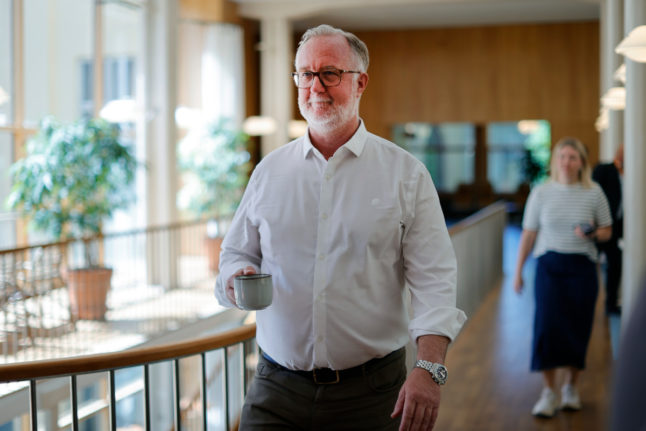Interest in EU elections remains low in Sweden, but it has seen a slow but steady increase, something which is likely to continue given the importance of cooperation at an EU level to respond to Russia’s invasion of Ukraine and deal with the climate crisis.
“Turnout has been much, much lower than in the domestic elections, where we typically are in the 80-85 percent range,” Hinnfors, a politics professor at Gothenburg University, told The Local. “EU elections have been in the 40 to 55 percent range. A couple of weeks ago, there was a poll indicating that most people weren’t even aware that there was going to be an EU election, and far fewer people could pinpoint the date.”
Nonetheless, turnout in the EU polls has been growing steadily, hitting a record 55 percent in 2019, at the same time as political parties are putting forward increasingly heavyweight politicians as MEP candidates.
Even at a national level, success or failure in the EU polls is seen as reflecting voters’ appraisal of the parties performances more generally.
“One thing which is new is that people are starting to regard the EU elections as an indicator of how the government is doing,” Hinnfors said.
READ ALSO: Can residents in Sweden vote in EU elections?
Tougher parliamentary threshold at an EU level
While the threshold for entering the EU parliament – at 4 percent of the vote — is the same as for the Swedish Riksdag, in reality it’s a much tougher hurdle.
“There are only 21 seats and there are no top-up seats, so it’s much more dangerous for the parties,” Hinnfors explained. “Even though there is a 4 percent threshold, the real threshold could be a one or more percentage points higher. Even if you get 4.5 percent to 5 percent, you might not get a seat.”
In addition, there is little or no tactical voting in EU elections.
“If you look at the parliamentary election, you get tactical voting to keep parties above the 4 percent threshold, because it might affect government formation. This doesn’t happen in the EU elections, because you don’t form a government there in that sense.”
This could make it even more difficult for parties, such as the Liberals, Christian Democrats, Greens and Centre Party, who relied on tactical voting in the 2022 election.
What’s at stake for the government parties?
The Christian Democrats currently have two MEPs and the Liberal Party only one, but Hinnfors believes that if it goes badly, it is quite possible that either or both could end up without a seat at all.
“It’s pretty clear that quite a big chunk, maybe a third of the vote [in the 2022 domestic election] for the Liberals and the Christian Democrats was Moderate Party voters,” he explains.
The Liberal Party typically does better in EU elections than it does domestically, but this might not be enought to save it from a wipe out, which in turn could see the party’s leader Johan Pehrson being replaced.
“The more educated you are, the more likely you are to vote, and that might speak in favour of the Liberals because their electorate is rather well educated,” Hinnfors said. “That might save them. But if they fail, that will I think put enormous pressure on the party leader. It’s a divided party in the first place and many people are upset about the cooperation with the Sweden Democrats.”
Ebba Busch, the leader of the Christian Democrats, is particularly exposed in this election because she overturned her party’s choice of lead candidate, David Lega, and instead imposed the debator Alice Teodorescu Måwe, who had until then been associated with the Moderates.
“If that backfires, with all this turmoil around the nomination procedures, then of course, that will put the pressure on the party leader, because it was her doing to parachute someone in to become the top candidate. She will probably survive losing one seat, but if they lose both seats, then there will be pressure.”
With four MEPs, the position of the Moderate Party in the European Parliament is much safer and the election result is unlikely to threaten Ulf Kristersson’s position as party leader, but it might be taken as evidence that his government is not doing that well in general.
“They just made it into a government position by the skin of their teeth, and of course, this position isn’t lovely to begin with, and then they’ve done rather badly in the national opinion polls,” Hinnfors said. “If if they perform badly, I think there will be pressure on him as well.”
What’s at stake for the Sweden Democrats?
The Sweden Democrats tend to underperform in EU elections. The 15.34 percent of the European vote they won in 2019 was below the 20.5 percent of the vote they went on to win in 2022 at a national level.
“The main problem for the Sweden Democrats is that their electorate is heavily skewed towards less educated people, so they really have to push people to vote, to really campaign in favour of voting,” Hinnfors said.
“They are still the most Eurosceptic party. They’ve left the Swexit position. But quite a lot of their campaign is still that the EU is a bad institution, while the population at large is far more positive now towards the EU, so I think they have a little bit of a challenge to convince people to vote for something that the party is sceptical about but about which the general population is more optimistic.”
Whatever the result, though, Hinnfors believes that the position of Jimmie Åkesson, the party’s leader, is safe. “I think if they can keep their seats, I think they will be happy.”
What’s at stake for the opposition parties?
Of the opposition parties, only the Centre Party looks vulnerable, while the Social Democrats, Green Party and Left Party will all be hoping to do well.
“The Social Democrats have always punched below their weight in EU elections. Their electorate is also tilted in the direction of less educated voters and they are a difficult group to make turn out and vote,” Hinnfors said. “They’ve usually received roughly 5 percent below their closest national election result.”
Given that the party is currently polling at about 35 percent in national opinion surveys, this 5 percent discount indicates they might be able to boost the 24 percent of the vote it won in the 2019 European elections to closer to 30 percent.
“I think this might be an election where they have something to cheer about,” Hinnfors said.
Both the Left Party and the Green Party are fielding former party leaders as candidates, with Jonas Sjöstedt fronting the Left Party’s campaign and Isabella Lövin joining the Green Party’s team.
Daniel Hellden, the new leader of the Green Party, will be hoping to use the EU elections to signal a turnaround for his party’s fortunes.
Hinnfors said that while the Green Party might struggle to match the 11.52 percent of the vote it won in 2019, it was likely to get a much higher share of the vote than the 5 percent it managed in the 2022 national elections.
“They have a very highly educated electorate, so in that sense, they probably won’t have any difficulties making their voters go out and vote and if you look at climate change, it’s on the agenda, so maybe that will be in their favour this election,” he said.
Sjöstedt, meanwhile, would be a strong draw for some voters, he predicted.
“He was very well respected and quite popular when he was party leader, and he also has a lot of European Parliament experience, because he was in European Parliament previously, so he knows the system.”
Compared to these parties, the Centre Party faces real issues, particularly as its lead candidate in the 2019 elections, Fredrick Federley, had to resign after it emerged that his live-in partner had previously served a prison sentence for child rape. Emma Wiesner, who replaced him in 2020, has failed to make much impact.
Given that the party’s new leader, Muharrem Demirok, has also failed to gain much of a profile at a national level, or boost the party’s support among voters, he is likely to face pressure even if the party loses one of its two MEPs, and definitely if it loses both.
“He has not been able yet to lift the party from the doldrums, and if they lose their seats, then the crosshair might be turned in his direction,” Hinnfors said.



 Please whitelist us to continue reading.
Please whitelist us to continue reading.
Member comments